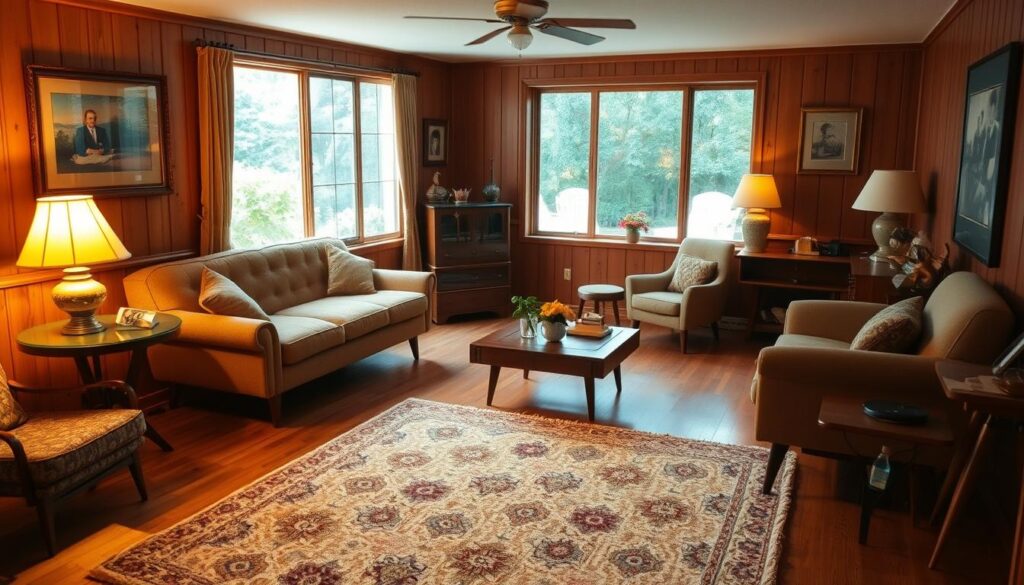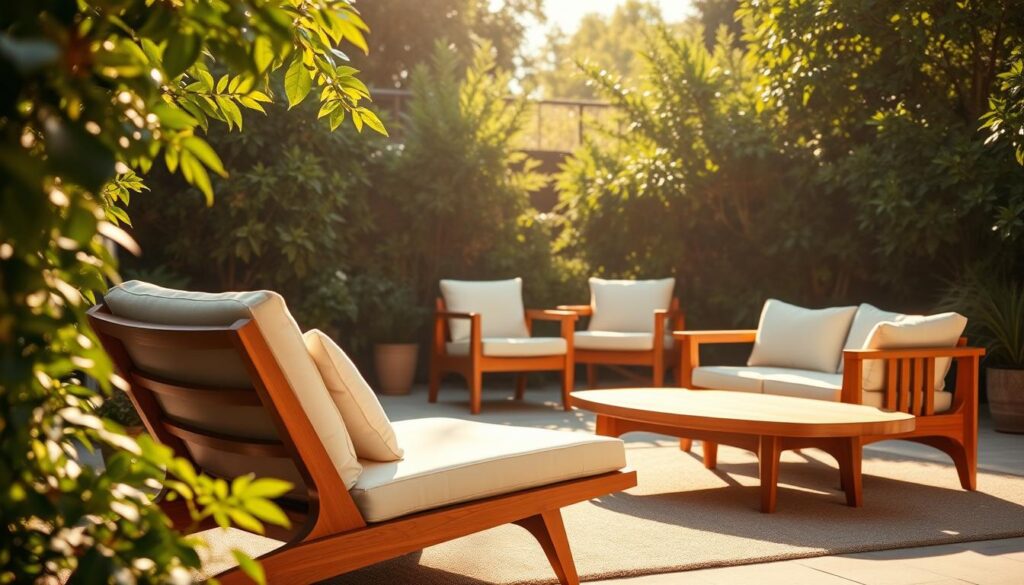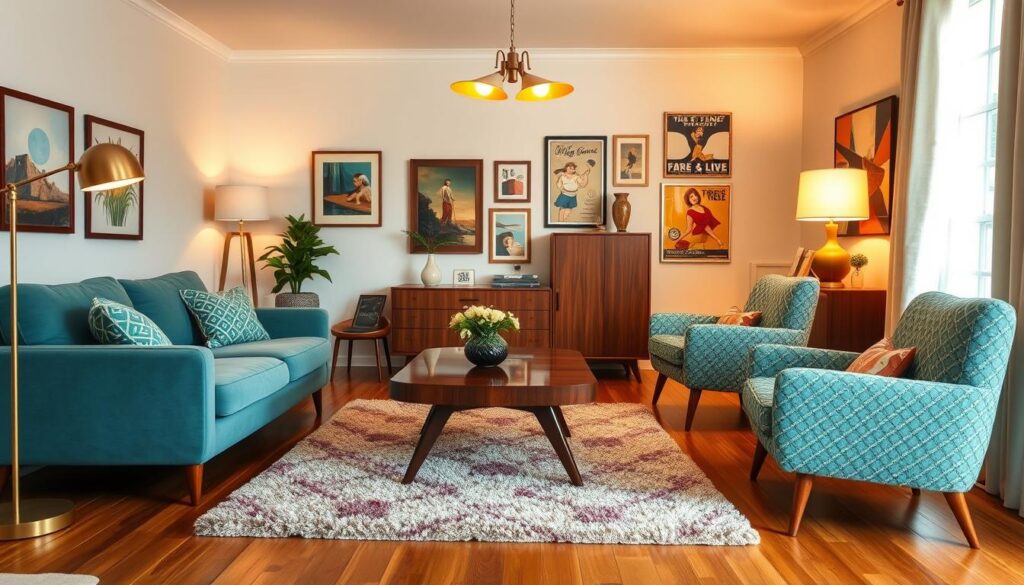The 1950s was a big change for interior design. It moved towards modernity, leaving the old behind. Retro home decor from this time is fun with colors, patterns, and new furniture designs.
Exploring 1950s interior design, you’ll see how to add iconic styles to your home. By knowing the trends of that time, you can make a cozy space that feels like the 1950s. Check out mid-century modern elements for inspiration.
Key Takeaways
- Understand the key characteristics of 1950s interior design.
- Learn how to incorporate retro home decor into your space.
- Discover the iconic furniture styles of the 1950s.
- Explore the color palettes that defined the era.
- Create a nostalgic haven with mid-century modern elements.
Understanding the 1950s Design Aesthetic
The 1950s design is known for its clean lines and organic shapes. It’s a mix of modern and nostalgic styles. This era’s design reflects post-war optimism and a return to traditional values.
Key Characteristics of 1950s Interiors
The 1950s interiors focused on functionality and simplicity. Clean lines and minimal ornamentation were key. These features show a cultural shift towards modernity.
There was also a big push to connect with nature. This was done through large windows, outdoor spaces, and natural materials in furniture and decor.
Color Palettes and Patterns
The 1950s had unique color palettes. They used pastel colors and bold, vibrant hues together. These colors were often paired with geometric patterns to add interest.
Popular patterns included chevrons, hexagons, and abstract motifs. These were used in textiles, wallpaper, and flooring.
| Color Palette | Common Patterns | Typical Use |
|---|---|---|
| Pastel colors with bold accents | Geometric patterns, abstract motifs | Textiles, wallpaper, flooring |
| Earth tones with bright highlights | Chevron, hexagon patterns | Furniture upholstery, decorative accessories |
Iconic Furniture Styles
The 1950s introduced the mid-century modern style furniture. It’s known for sleek lines, organic shapes, and functional design. The Eames Lounge Chair and Noguchi Coffee Table are iconic pieces from this era.
“The modern home is not a shelter, it’s a way of life.” – Charles Eames
These furniture pieces not only showed the era’s design principles. They also changed how people lived and interacted in their homes.
Essential Furniture Pieces for a 1950s Home
The 1950s home is a mix of modern and nostalgic. It uses new materials and technologies in its design. To get the 1950s look right, you need the right furniture.
The Role of Mid-Century Modern Furniture
Mid-century modern furniture was key in the 1950s. It’s known for sleek lines and simple shapes. The Eames Lounge Chair and Noguchi Coffee Table are perfect examples.
Must-Have Accessories and Decor
Accessories and decor were important in the 1950s. Things like sputnik chandeliers and atomic print textiles were big. They made the space feel real.
- Sputnik chandeliers
- Atomic print textiles
- Vintage vases and decorative items
Incorporating Vintage Finds
Adding vintage items makes your 1950s home feel authentic. You can find these at thrift stores, antique shops, and online. Choose items that match your design and are in good shape.
| Vintage Piece | Condition to Look For | Tips for Incorporation |
|---|---|---|
| Furniture | Minimal wear, original finish | Use as statement pieces or refurbish |
| Textiles | Good condition, vibrant colors | Use for upholstery or as decorative accents |
| Decorative Items | Unique, minimal damage | Display prominently to add character |
By choosing mid-century modern furniture, adding key accessories, and using vintage items, you can make a 1950s home. It will be both nostalgic and stylish.
Choosing the Right Color Scheme
Choosing the right colors is key to a 1950s home interior that looks classic. The 1950s had a unique color palette. It mixed soft pastels with bold colors, making spaces vibrant and unique.
Popular Colors of the 1950s
The 1950s had a wide range of colors. Soft pastels and bold, bright hues were common. Iconic colors include:
- Soft pastels like mint green, pale pink, and baby blue
- Bold primaries such as red, yellow, and blue
- Earth tones like beige and turquoise
How to Combine Colors Effectively
It’s important to mix colors right to capture 1950s décor. Here are some tips:
- Balance bold colors with neutral backgrounds to avoid overwhelming the space.
- Use pastel shades to add a touch of softness and elegance.
- Consider the 60-30-10 rule: 60% dominant color, 30% secondary color, and 10% accent color.
By following these tips, you can make a color scheme that’s both authentic and beautiful.
The Impact of Wallpaper
Wallpaper was big in 1950s homes, adding pattern and texture. To use wallpaper well:
- Choose designs that reflect the era, such as geometric patterns or floral motifs.
- Use wallpaper on a single accent wall to create a focal point.
- Pair wallpaper with solid-colored walls to achieve a balanced look.
By carefully picking and mixing colors and patterns, you can bring a 1950s classic look to your home.
Flooring Options for a 1950s Aesthetic
Flooring was key in 1950s interiors, offering many options for a retro look. The right flooring can make your home feel like it’s from the fabulous fifties. It brings back the era’s style and charm.
Classic Hardwood vs. Linoleum
In the 1950s, people chose between hardwood and linoleum for floors. Hardwood flooring was loved for its durability and timeless look. On the other hand, linoleum was great for kitchens and bathrooms because it’s water-resistant.
| Flooring Type | Durability | Maintenance |
|---|---|---|
| Hardwood | High | Moderate |
| Linoleum | High | Low |
As
“Linoleum is a highly practical and versatile flooring option that was widely used in the 1950s,”
interior design historian Jane Smith says. Its many patterns and colors made it a favorite for adding personality to floors.
Area Rugs to Complement Your Design
Area rugs were crucial in 1950s decor, adding warmth and texture. They came in many patterns, from geometric to floral. Choosing a rug that fits your retro theme can enhance your home’s look.

Adding Character with Tiles
Tiles were common in 1950s kitchens and bathrooms, giving a clean, modern feel. They were durable and easy to clean, perfect for wet areas. Tiles, from white subway to colorful mosaics, added sophistication and whimsy.
- Subway tiles for a sleek, modern look
- Mosaic tiles for a decorative touch
- Hexagonal tiles for a unique, retro flair
Using these flooring options can bring the 1950s design into your home. It creates a space that’s both nostalgic and stylish.
Lighting Styles to Enhance Your Space
In the 1950s, lighting was more than just a need; it was a statement piece. The mid-century modern style brought innovative designs that enhanced home ambiance.
Types of Lighting Fixtures
The 1950s introduced creative lighting, like sputnik chandeliers and sculptural table lamps. These were not just lights but art pieces that showed the era’s design spirit. For those wanting this style, mid-century modern lighting is easy to find.
Vintage Light Bulbs and Their Appeal
Vintage light bulbs added a warm glow to 1950s homes. This soft light made spaces cozy and inviting, key to vintage house design.
Creating the Right Atmosphere
To match a 1950s home, balance your lighting and pick fixtures that fit the design. Layering different lights creates a welcoming feel. Here are some tips:
- Use a mix of overhead, table, and floor lamps.
- Choose fixtures that match the era’s style.
- Think about light bulb color temperature for warmth.
| Lighting Fixture | Description | Era Relevance |
|---|---|---|
| Sputnik Chandeliers | Decorative fixtures with multiple arms | Highly popular in the 1950s |
| Table Lamps | Sculptural shapes, often with atomic motifs | Iconic of mid-century modern design |
| Floor Lamps | Tall, slender designs with minimalist shades | Common in 1950s living rooms |
By choosing and balancing lighting fixtures, you can bring 1950s design into your home. This creates a space that feels both nostalgic and welcoming.
Incorporating Technology into a 1950s Design
To mix old charm with new tech in a 1950s home, think carefully. The 1950s brought big changes, like TVs and new kitchen tools. These changes are key to a modern 1950s home.
Retro Appliances that Fit the Style
For a true 1950s vibe, pick retro-style appliances. Brands like Smeg and Big Chill offer appliances that look old but work like new. They come in cool colors like pastels.
“Retro style is more than looks,” says interior designer. “It’s about bringing old charm into today’s homes. Retro appliances make kitchens stand out.”
Maintaining a Balanced Tech Look
Adding modern tech to a 1950s home is key. Use old-style cabinets to hide new TVs. Decorative screens can also hide today’s gadgets.
- Choose vintage furniture with hidden spots for modern tech.
- Go for wireless tech to hide cables.
- Find lights that also charge devices.
Innovations from the Era
The 1950s were full of new ideas, like TVs, stereo systems, and better appliances. Knowing these changes helps you pick the right tech for your 1950s home.
“The 1950s changed home entertainment with TVs. This change also changed how we decorate living rooms.”
By mixing 1950s charm with today’s tech, you can have a home that’s both old and new.
Tips for Room-by-Room Styling
Styling a 1950s home requires attention to each room’s unique charm. It’s not just about furniture; it’s about bringing back the 1950s lifestyle. We’ll show you how to style your living room, kitchen, and bedrooms with a classic 1950s look.
Living Room Essentials
The living room is the home’s heart, and in the 1950s, it’s all about the retro vibe. Use mid-century modern furniture to set the tone. Think sleek sofas, wooden coffee tables, and armchairs with clean lines.
Add vintage accessories like lamps or rugs with retro patterns. For a real 1950s feel, check out antique stores or flea markets. Design experts say mixing modern comfort with vintage charm is key.
For inspiration, visit Ouma Atelier. They share tips on blending old with new in tiny homes, perfect for small spaces.
Kitchen with a Vintage Flair
The 1950s kitchen is all about nostalgia and function. Use retro appliances and classic décor. Vintage-style refrigerators and stoves, along with retro dishware, add to the charm.
Pastel-colored appliances or chrome accents also enhance the 1950s look. The kitchen’s layout and materials are key. Think linoleum flooring and Formica countertops for a complete look.
Bedrooms that Reflect the Era
1950s bedrooms are cozy and intimate. Choose classic furniture like wooden bed frames and vintage dressers. Comfortable bedding with retro patterns is essential.
Soft pastel colors or bold patterns on wallpaper set the mood. Vintage bedding and curtains add authenticity. It’s the small details that make a room feel truly 1950s.
Outdoor Spaces: Bringing the 1950s Outside
The 1950s were not just about interior design; the era’s charm extended to outdoor living areas as well. As we explore how to style a 1950s home interior, it’s essential to consider the outdoor spaces that complement this aesthetic.
Creating a Retro Patio Area
A retro patio area is perfect for entertaining and can be achieved with the right furniture and decor. Consider using mid-century modern style outdoor furniture, which often features clean lines, organic shapes, and an emphasis on functionality.

Recommended Outdoor Furniture
Outdoor furniture from the 1950s often included materials like wrought iron, aluminum, and natural woods. Look for pieces that have a nostalgic feel, such as:
- Wrought iron patio sets with intricate designs
- Aluminum chairs with cushions in bold, geometric patterns
- Wooden benches with a natural finish
Landscaping Ideas Inspired by the Era
Landscaping in the 1950s was characterized by a mix of modernity and traditional elements. To capture this look, consider incorporating:
“The garden is a love song, a duet between a human being and Mother Nature.” – Allen Lacy
Elements like lawn ornaments, outdoor lighting, and carefully manicured hedges can evoke the charm of the 1950s. Don’t forget to add some retro-style planters and garden furniture to complete the look.
Maintaining Authenticity in Modern Living Spaces
Keeping a 1950s home feeling true to its era while adding modern touches is a fun challenge. It’s key to mix old charm with new needs smoothly.
Blending Old and New
For a 1950s-inspired look, mix old style with today’s needs. You can update a vintage sofa with new fabric but keep its classic feel. Adding modern lights with a retro twist also works well.
Where to Source Authentic Pieces
Finding real 1950s items or their modern versions is crucial. Thrift stores, antique shops, and online sites are great for vintage finds. Also, many makers now create 1950s-style pieces, making it easier to find what you need.
Avoiding Common Mistakes
One big mistake is overdoing it with too many styles. Balance is key. Also, don’t forget the era’s iconic colors and patterns. Using these wisely makes your space feel real and connected to the past.
Knowing how to mix old and new, where to find authentic items, and what to avoid helps. This way, your 1950s-themed home will be both stylish and practical. It will be a place that feels both nostalgic and modern.
Conclusion: Celebrating the 1950s in Our Homes
As we wrap up our guide to 1950s home styling, we’ve looked at what makes this era special. By adding vintage touches and classic pieces, you can make your home feel nostalgic and welcoming.
Key Takeaways
We’ve talked about important furniture, colors, and lighting to get that 1950s vibe. Mid-century modern furniture and retro appliances will make your home lively.
Embracing Retro Aesthetics
The 1950s design is about loving the past but making it fit today’s life. Mixing old and new lets you show off your style in a unique way.
Share Your Journey
We invite you to share your 1950s-inspired home on social media. Use hashtags to connect with others who love vintage design.


